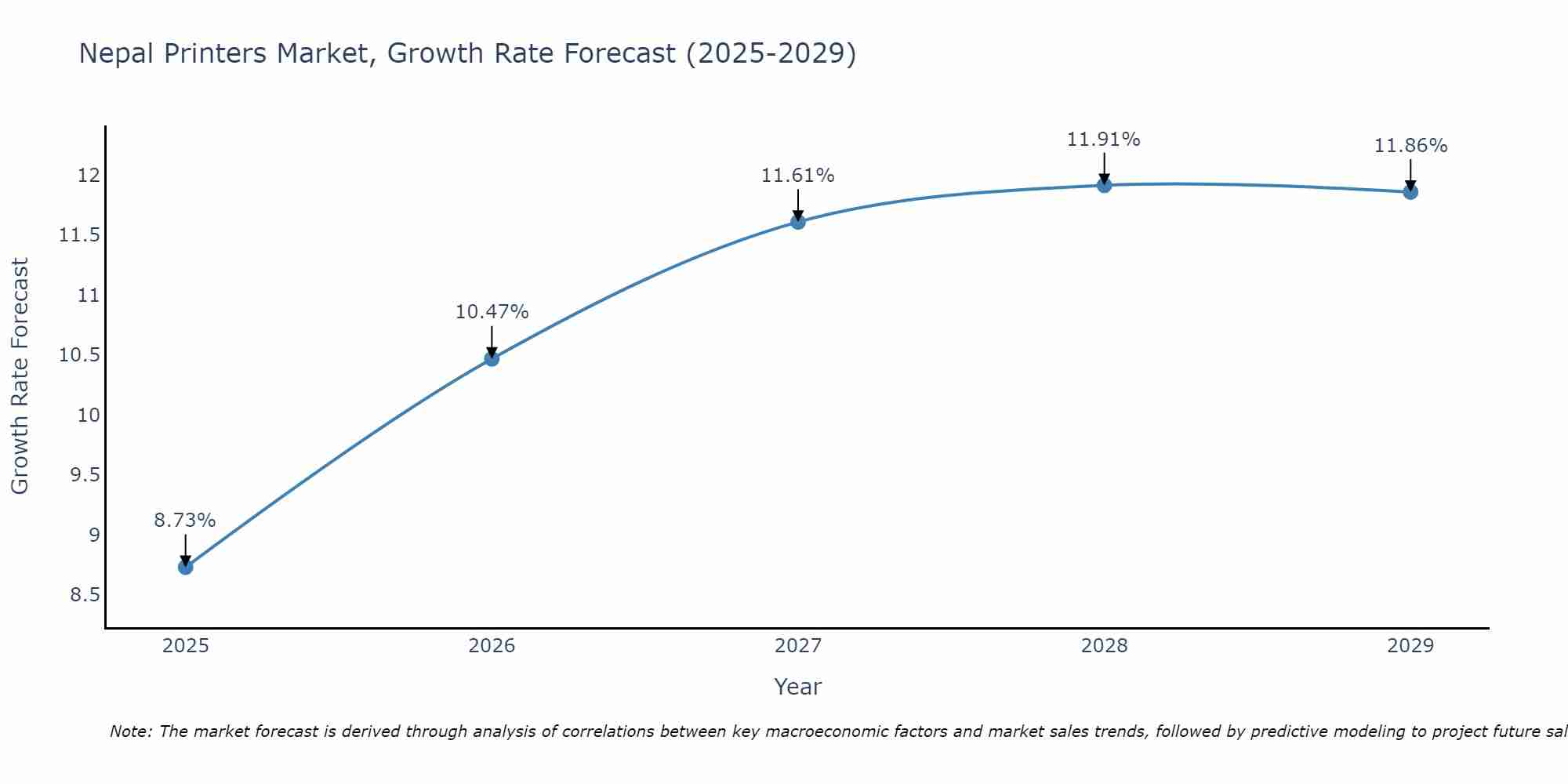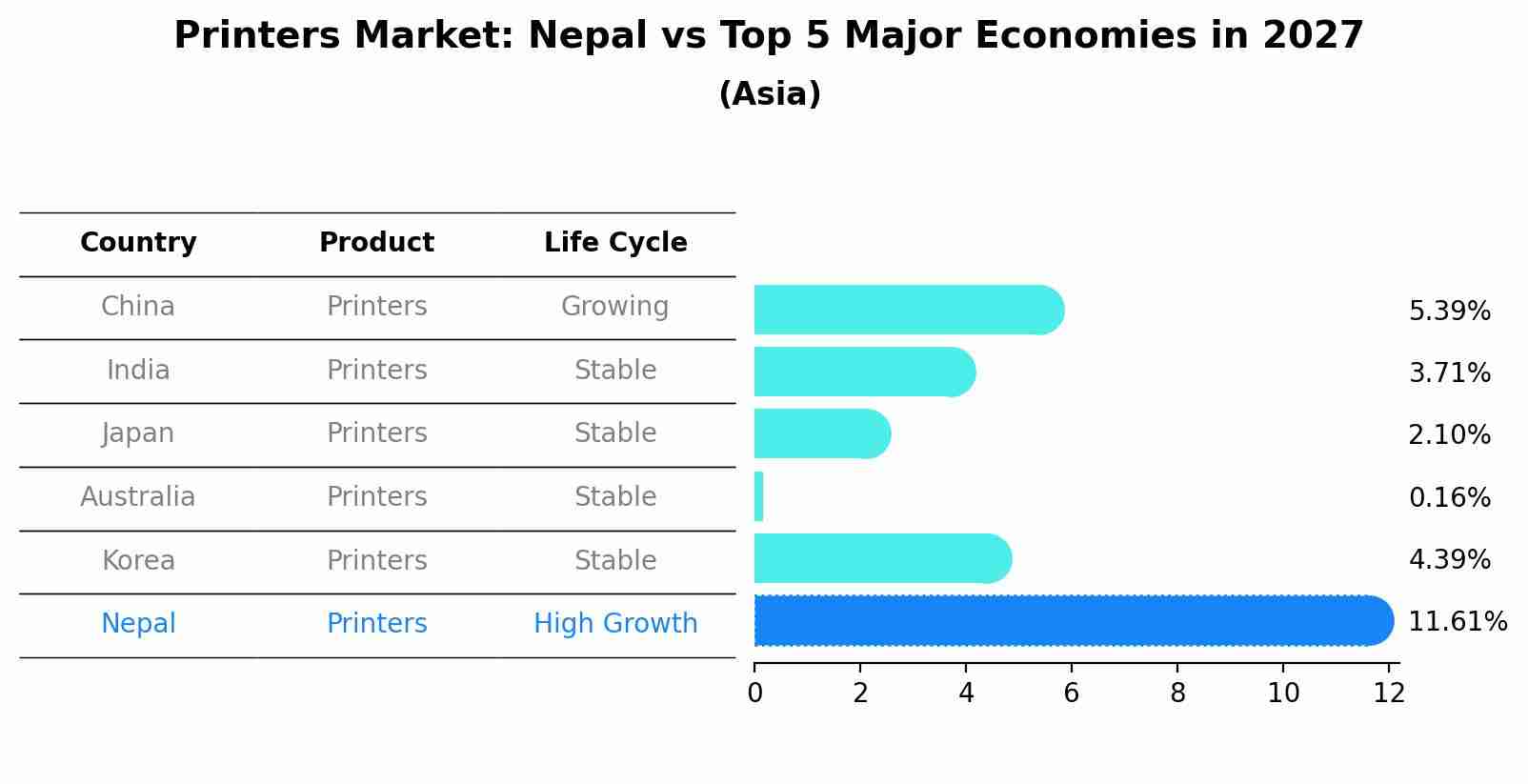Nepal Printers Market (2025-2031) | Outlook, Value, Size, Companies, Trends, Forecast, Industry, Analysis, Revenue, Growth & Share
| Product Code: ETC040577 | Publication Date: Jan 2021 | Updated Date: Jun 2025 | Product Type: Report | |
| Publisher: 6Wresearch | Author: Bhawna Singh | No. of Pages: 70 | No. of Figures: 35 | No. of Tables: 5 |
Nepal Printers Market Size Growth Rate
The Nepal Printers Market is projected to witness mixed growth rate patterns during 2025 to 2029. The growth rate begins at 8.73% in 2025, climbs to a high of 11.91% in 2028, and moderates to 11.86% by 2029.

Printers Market: Nepal vs Top 5 Major Economies in 2027 (Asia)
In the Asia region, the Printers market in Nepal is projected to expand at a high growth rate of 11.61% by 2027. The largest economy is China, followed by India, Japan, Australia and South Korea.

Nepal Printers Market Overview
The Nepal printers market is experiencing steady growth driven by increasing demand for both personal and business use. Inkjet printers are popular among consumers due to their affordability and versatility, while laser printers are preferred by businesses for their speed and cost-effectiveness. The market is becoming more competitive with the entry of international brands alongside local manufacturers offering a wide range of printers catering to various needs and budgets. Factors such as rising digitization, remote working trends, and growing awareness about the benefits of printing technology are further fueling market expansion. Additionally, the government`s initiatives to promote digital literacy and education are expected to drive the adoption of printers in schools and offices across Nepal, presenting opportunities for market players to innovate and differentiate their products.
Nepal Printers Market Trends
The Nepal Printers Market is experiencing a shift towards multifunctional printers that combine printing, scanning, and copying capabilities in a single device. This trend is driven by the increasing demand for efficient and space-saving solutions in offices and homes. Additionally, there is a growing preference for wireless and cloud printing options to enhance connectivity and convenience. Eco-friendly printers that consume less energy and use recycled materials are also gaining traction in the market as environmental consciousness rises among consumers and businesses. As technology continues to advance, there is a noticeable preference for printers with mobile printing capabilities and compatibility with smartphones and tablets. Overall, the Nepal Printers Market is witnessing a transformation towards more versatile, sustainable, and technologically advanced printing solutions.
Nepal Printers Market Challenges
The Nepal printers market faces several challenges, including high import tariffs on printing equipment and materials, which can increase production costs for local printing businesses. Additionally, the market is highly fragmented with many small-scale printing companies competing for limited demand, leading to price wars and margin pressures. Limited access to advanced printing technologies and skilled workforce also pose challenges in meeting the evolving needs of customers for high-quality and customized printing solutions. Furthermore, inadequate infrastructure and logistics support in certain regions of Nepal can hinder the timely delivery of printed materials, impacting customer satisfaction. Overall, addressing these challenges will require strategic investments in technology, workforce training, and infrastructure improvements to drive growth and competitiveness in the Nepal printers market.
Nepal Printers Market Investment Opportunities
Investment opportunities in the Nepal Printers Market include the growing demand for digital printing services due to increasing advertising and marketing needs in various industries. Investing in advanced digital printing equipment can provide a competitive edge in offering high-quality, quick turnaround printing solutions to businesses. Additionally, there is a rising trend towards eco-friendly printing practices, creating opportunities for investments in sustainable printing technologies and materials. As Nepal`s economy continues to develop, there is potential for expansion in the packaging and labeling segments, which require specialized printing services. Overall, investing in modernizing printing technologies, diversifying service offerings, and incorporating sustainable practices can position investors well in the evolving Nepal Printers Market.
Nepal Printers Market Government Policy
Government policies related to the Nepal Printers Market include regulations on import and export of printers and printer supplies, taxation on printing equipment and materials, and environmental standards for printing companies to adhere to. The government also provides incentives and support for promoting the growth of the printing industry through subsidies, training programs, and infrastructure development. Additionally, there are regulations in place to monitor and control the quality of printed materials to ensure consumer safety and satisfaction. Overall, government policies in Nepal aim to create a conducive environment for the printers market to thrive while also ensuring compliance with legal and environmental standards.
Nepal Printers Market Future Outlook
The Nepal printers market is expected to witness steady growth in the coming years, driven by increasing demand for printing services across various sectors such as education, government, and businesses. The rise of digital printing technology and the growing popularity of online printing services are also contributing to the market expansion. Additionally, the government`s initiatives to promote digitization and the adoption of advanced printing solutions are likely to further bolster market growth. However, factors such as intense competition, price sensitivity among consumers, and the impact of the COVID-19 pandemic on the economy may present challenges for market players. Overall, the Nepal printers market is poised for growth, with opportunities for innovation and technological advancements to meet evolving customer needs.
Key Highlights of the Report:
- Nepal Printers Market Outlook
- Market Size of Nepal Printers Market, 2024
- Forecast of Nepal Printers Market, 2026
- Historical Data and Forecast of Nepal Printers Revenues & Volume for the Period 2021 - 2031
- Nepal Printers Market Trend Evolution
- Nepal Printers Market Drivers and Challenges
- Nepal Printers Price Trends
- Nepal Printers Porter's Five Forces
- Nepal Printers Industry Life Cycle
- Historical Data and Forecast of Nepal Printers Market Revenues & Volume By Type for the Period 2021 - 2031
- Historical Data and Forecast of Nepal Printers Market Revenues & Volume By Multifunction printers for the Period 2021 - 2031
- Historical Data and Forecast of Nepal Printers Market Revenues & Volume By Single function printers for the Period 2021 - 2031
- Historical Data and Forecast of Nepal Printers Market Revenues & Volume By Technology for the Period 2021 - 2031
- Historical Data and Forecast of Nepal Printers Market Revenues & Volume By Laser for the Period 2021 - 2031
- Historical Data and Forecast of Nepal Printers Market Revenues & Volume By Inkjet for the Period 2021 - 2031
- Historical Data and Forecast of Nepal Printers Market Revenues & Volume By Others for the Period 2021 - 2031
- Nepal Printers Import Export Trade Statistics
- Market Opportunity Assessment By Type
- Market Opportunity Assessment By Technology
- Nepal Printers Top Companies Market Share
- Nepal Printers Competitive Benchmarking By Technical and Operational Parameters
- Nepal Printers Company Profiles
- Nepal Printers Key Strategic Recommendations
Frequently Asked Questions About the Market Study (FAQs):
1 Executive Summary |
2 Introduction |
2.1 Key Highlights of the Report |
2.2 Report Description |
2.3 Market Scope & Segmentation |
2.4 Research Methodology |
2.5 Assumptions |
3 Nepal Printers Market Overview |
3.1 Nepal Country Macro Economic Indicators |
3.2 Nepal Printers Market Revenues & Volume, 2019 & 2026F |
3.3 Nepal Printers Market - Industry Life Cycle |
3.4 Nepal Printers Market - Porter's Five Forces |
3.5 Nepal Printers Market Revenues & Volume Share, By Type, 2021 & 2031F |
3.6 Nepal Printers Market Revenues & Volume Share, By Technology, 2019 & 2026F |
4 Nepal Printers Market Dynamics |
4.1 Impact Analysis |
4.2 Market Drivers |
4.3 Market Restraints |
5 Nepal Printers Market Trends |
6 Nepal Printers Market, By Types |
6.1 Nepal Printers Market, By Type |
6.1.1 Overview and Analysis |
6.1.2 Nepal Printers Market Revenues & Volume, By Type, 2016 - 2026F |
6.1.3 Nepal Printers Market Revenues & Volume, By Multifunction printers, 2016 - 2026F |
6.1.4 Nepal Printers Market Revenues & Volume, By Single function printers, 2016 - 2026F |
6.2 Nepal Printers Market, By Technology |
6.2.1 Overview and Analysis |
6.2.2 Nepal Printers Market Revenues & Volume, By Laser, 2016 - 2026F |
6.2.3 Nepal Printers Market Revenues & Volume, By Inkjet, 2016 - 2026F |
6.2.4 Nepal Printers Market Revenues & Volume, By Others, 2016 - 2026F |
7 Nepal Printers Market Import-Export Trade Statistics |
7.1 Nepal Printers Market Export to Major Countries |
7.2 Nepal Printers Market Imports from Major Countries |
8 Nepal Printers Market Key Performance Indicators |
9 Nepal Printers Market - Opportunity Assessment |
9.1 Nepal Printers Market Opportunity Assessment, By Type, 2019 & 2026F |
9.2 Nepal Printers Market Opportunity Assessment, By Technology, 2019 & 2026F |
10 Nepal Printers Market - Competitive Landscape |
10.1 Nepal Printers Market Revenue Share, By Companies, 2024 |
10.2 Nepal Printers Market Competitive Benchmarking, By Operating and Technical Parameters |
11 Company Profiles |
12 Recommendations |
13 Disclaimer |
- Single User License$ 1,995
- Department License$ 2,400
- Site License$ 3,120
- Global License$ 3,795
Search
Thought Leadership and Analyst Meet
Our Clients
Related Reports
- Afghanistan Apparel Market (2026-2032) | Growth, Outlook, Industry, Segmentation, Forecast, Size, Companies, Trends, Value, Share, Analysis & Revenue
- Canada Oil and Gas Market (2026-2032) | Share, Segmentation, Value, Industry, Trends, Forecast, Analysis, Size & Revenue, Growth, Competitive Landscape, Outlook, Companies
- Germany Breakfast Food Market (2026-2032) | Industry, Share, Growth, Size, Companies, Value, Analysis, Revenue, Trends, Forecast & Outlook
- Australia Briquette Market (2025-2031) | Growth, Size, Revenue, Forecast, Analysis, Trends, Value, Share, Industry & Companies
- Vietnam System Integrator Market (2025-2031) | Size, Companies, Analysis, Industry, Value, Forecast, Growth, Trends, Revenue & Share
- ASEAN and Thailand Brain Health Supplements Market (2025-2031) | Strategy, Consumer Insights, Analysis, Investment Trends, Opportunities, Growth, Size, Share, Industry, Revenue, Segments, Value, Segmentation, Supply, Forecast, Restraints, Outlook, Competition, Drivers, Trends, Demand, Pricing Analysis, Competitive, Strategic Insights, Companies, Challenges
- ASEAN Bearings Market (2025-2031) | Strategy, Consumer Insights, Analysis, Investment Trends, Opportunities, Growth, Size, Share, Industry, Revenue, Segments, Value, Segmentation, Supply, Forecast, Restraints, Outlook, Competition, Drivers, Trends, Demand, Pricing Analysis, Competitive, Strategic Insights, Companies, Challenges
- Europe Flooring Market (2025-2031) | Outlook, Share, Industry, Trends, Forecast, Companies, Revenue, Size, Analysis, Growth & Value
- Saudi Arabia Manlift Market (2025-2031) | Outlook, Size, Growth, Trends, Companies, Industry, Revenue, Value, Share, Forecast & Analysis
- Uganda Excavator, Crane, and Wheel Loaders Market (2025-2031) | Strategy, Consumer Insights, Analysis, Investment Trends, Opportunities, Growth, Size, Share, Industry, Revenue, Segments, Value, Segmentation, Supply, Forecast, Restraints, Outlook, Competition, Drivers, Trends, Demand, Pricing Analysis, Competitive, Strategic Insights, Companies, Challenges
Industry Events and Analyst Meet
Whitepaper
- Middle East & Africa Commercial Security Market Click here to view more.
- Middle East & Africa Fire Safety Systems & Equipment Market Click here to view more.
- GCC Drone Market Click here to view more.
- Middle East Lighting Fixture Market Click here to view more.
- GCC Physical & Perimeter Security Market Click here to view more.
6WResearch In News
- Doha a strategic location for EV manufacturing hub: IPA Qatar
- Demand for luxury TVs surging in the GCC, says Samsung
- Empowering Growth: The Thriving Journey of Bangladesh’s Cable Industry
- Demand for luxury TVs surging in the GCC, says Samsung
- Video call with a traditional healer? Once unthinkable, it’s now common in South Africa
- Intelligent Buildings To Smooth GCC’s Path To Net Zero


















